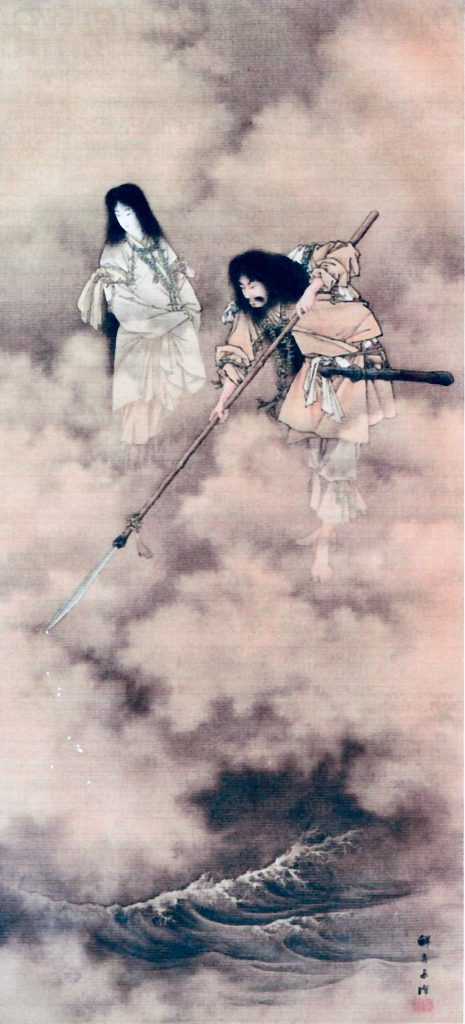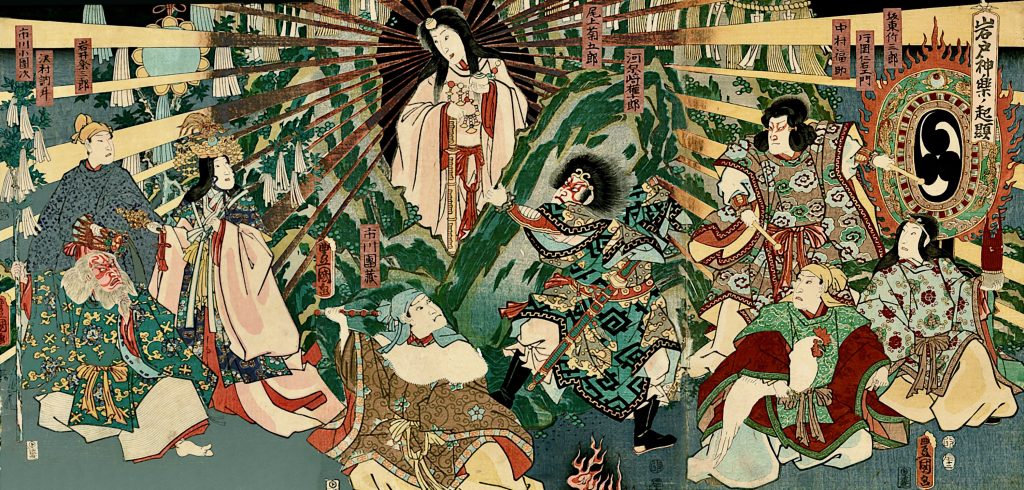Beginnings: Myths and stories from world religions
A curriculum for upper elementary grades by Dan Harper
Copyright (c) 2014, 2024 Dan Harper.
(This lesson plan updated 2 August 2024.)
Back to Table of Contents | On to Session 3
The Floating Bridge of Heaven: A Shinto Story from Japan
The people of Japan have lived for centuries on eight large islands and many smaller islands that lie off the coast of China. For many years, they kept themselves separate from the rest of the world, living on their island, and avoiding contact with foreigners.
The Japanese people have religious practices that go back to the days before the Japanese began writing down their history. These religious practices still continue today, and are known by the name Shinto.
If you have ever watched the sun rise or set over the ocean you will know why the Shinto religion feels so much reverence for the sun. If you were to imagine the best dwelling place for the greatest and most beautiful of the gods and goddesses, you could think of none more glorious than in the brightly-colored skies of sunrise or sunset.
Two of the oldest of Japanese books are the Kojiki and the Nihongi. The Kojiki was written in the year 712 C.E., and the Nihongi was written in the year 720 C.E. Both books contain old myths and legends from various parts of Japan. While both these two books are held in great honor by those who follow the Shinto religion, most people would not be able to recite any passage from them, nor would most people even read them.
The first chapter in the Nihongi tells of the creation of the world, and it tells about the powerful sun goddess Amaterasu (Ah-mah-ter-ah’-soo).

The Floating Bridge of Heaven
In the beginning times, Heaven and Earth were not yet separated. They formed a chaotic mass like an egg, which didn’t have firm boundaries. The lighter and clearer part was thin and formed Heaven, while the heavier part settled down and became Earth. The lighter parts came together easily, but the heavier parts took a long time to come together. So Heaven was formed first, and Earth came later.
After Earth and Heaven came into being, heavenly beings came out of the space between the two. Six generations of these heavenly beings came and went, but not much is known about them. Finally came the seventh generation, whose names were Izanagi and Izanami. These two became the creator deities.
Izanagi and Izanami stood on the floating bridge of Heaven, and held counsel about what they should do. They asked each other, “Is there not a country beneath us?” Together they thrust the “Jewel-Spear of Heaven” (Ame no tama-boko) down through the clouds. Groping about with it, they found the ocean. The salty water which dripped from the point of the spear formed a solid island called Onogoro-jima (which means ‘Self-Coagulating Island’).
Izanagi and Izanami descended from the floating bridge of heaven and dwelt on Onogoro-jima. There they erected a house some 16 yards high, with a grand central pillar in it.
Then Izanagi said, “Let each of us go round the heavenly pillar. When we meet at the other side, let us become united in marriage.”
Izanami agreed to this.
Izanagi said, “You go round from the left, and I will go round from the right.”
When they had gone round, Izanami spoke first and exclaimed, “How delightful! I have met a lovely young man.”
Izanagi then said, “How delightful! I have met a lovely woman.” But he was annoyed because Izanami spoke first; he thought he, as the male god, should speak first.
Following their marriage, the couple had many children. Among their children were many gods and goddesses: Iha-tsuchi-biko, the Rock-earth-prince; Oho-ya-biko, the great-house-prince; the Wind-Gods; Ame no Mikumari, who distributes water from heaven; the Goddess of Food; and so on. The last deity to be born was Kagu-tsuchi, the God of Fire. When she gave birth to him, Izanagi was badly burned and died. Izanami was so angry that he cut Kagu-tsuchi to pieces with his sword, thus creating a number of new deities.
Izanagi visited Izanami in the land of the dead, but could not bring her back. When he washed himself after returning from the land of the dead, several new deities were created, including Amaterasu, the Sun-goddess, and Susano-o, the ruler of the Underworld.
Before Susano-o took up his duties as the ruler of the underworld, he asked his elder sister, Amaterasu, if he could come to heaven to take leave from her. She agreed. At first, all went well. But then Susano-o became rude and unseemly.
Susano-o broke down the divisions between the rice-fields belonging to his sister, sowed them over again, and let the piebald colt who lived in Heaven run through the fields, trampling them. Then Susano-o misbehaved in the great hall where Amaterasu was celebrating the solemn festival of the first fruits to be harvested. Finally, Susano-o killed a piebald colt of Heaven, skinned it, and threw the dead body into the sacred weaving-hall where the Sun-Goddess was at her loom weaving the garments of the deities.
Amaterasu was so offended by this last insult that she entered the Rock-cave of Heaven and left the world to darkness.
When Amaterasu hid herself in the Rock-cave of Heaven, the other deities grew worried, for there was no light any more. Everything was in complete darkness. All the other deities met on the dry bed of the River of Heaven to figure out a way to bring Amaterasu out of hiding.
First, Omoikane, the god of wisdom, brought roosters to the cave to crow, hoping to bring Amaterasu out that way.
Then Ame-no-Koyane, whom Amaterasu had put in charge of the divine mirror, and who was in charge of divine affairs in the palace, dug up a five-hundred branched Sakaki tree of Heaven. He hung strings of jewels on its higher branches, a mirror on its middle branches, and on its lower branches pieces of cloth. Then all the deities recited prayers in honor of Amaterasu.
Finally, Ame-no-Uzume, the goddess of Dawn and the Dread Female of Heaven, dressed herself in strange and fantastic clothing. She kindled a fire and pounded on a tub, danced wildly, and spoke inspired words. The Plain of High Heaven shook, and the eight hundred deities all laughed together.
The Sun-Goddess wondered how Ame-no-Uzume and the other gods could be so jolly while the world was wrapped in complete darkness. She peeped out from the half-opened door of the cave. She was at once seized by Ame-no-Tajikarao, or Heaven-Hand-Power. He kept her from slipping back into the cave, to the great joy of all the deities.
After the Sun Goddess was out of the cave and once more lighting up the world, a council of the deities put Susano-o on trial. He was found guilty, and caused to pay an enormous fine. They also pulled out the nails of his fingers and toes, and banished him to the land of the underworld. Finally Ame no Koyane, the ancestor of the Nakatomi, recited his Oho-harahi or “Great purification” liturgy.
Source: W. G. Aston, Shinto: The Way of the Gods (London: Longmans, Green, and Co., 1905), chapter VI.

Unit One: Five Myths from Four Peoples
Session Two: A Shinto Story from Japan
0/ Attend the first 10 minutes of the main services with the rest of the congregation.
I/ Opening
Take attendance.
Light chalice with these words and the associated hand motions: “We light this chalice to celebrate Unitarian Universalism: the church of the open mind, the helping hands, and the loving heart.”
Check-in: Go around circle. Each child and adult says his or her name, and then may say one good thing and one bad thing that has happened in the past week (anyone may pass).
Review last week: If you took photos of last week’s skit, show them to the children, and have them help you post them on the class bulletin board (remember to leave lots of room on the class bulletin board for pictures from future classes).
II/ Read the story
Read “From the Floating Bridge of Heaven.”
III/ Act out the story
This is a more complicated story than last week, and we will build the skills of the children in remembering the story, and acting out as accurately as possible.
Ask: “Who are the characters in this story?”
Ask: “What happened first in the story? Then what happened? then what happened?” — and so on, until (with your help and prompting as needed) the children have remembered what happened in the story.
Determine where the stage area will be. Children who are not actors may sit facing the stage area.
The lead teacher reads the story, prompting actors as needed to act out their parts. Actors do not have to repeat dialogue, although some of them will want to do so. The lead teacher may wish to simplify the story on the fly, to make it easier to act out. You will notice that this story is in two parts: the creation of the world by Izanagi and Izanami; and the Amaterasu story.
Once again, take photos with a digital camera, and print them out to be posted on the class bulletin board.
IV/ Conversation about the story
Sit back down in a group.
Ask some general questions: “What was the best part of the story? Who was your favorite character? Who was your least favorite character?” — or questions you come up with on your own.
Ask some questions specific to the story: “In this story, the sun goddess is a woman. Do you think of the sun as being male, or female, or neither? Why did Amaterasu get angry with her brother? Why did she hide in her cave? How would you have tempted her out of the cave?” — or questions you come up with on your own.
You can continue the conversation in any way you wish.
V/ Free play
Ideas for free play: “Duck, Duck, Goose”; Legos or other building toys; walk to front play area; etc.
VI/ Closing circle
Before leaving, have the children stand in a circle.
When the children are in a circle, ask them what they did today, and prompt them with questions and answers, e.g.: “What did we do today? We heard a story, right? Anyone remember what the story was about? It was about the Moon and the Hare, etc.” You’re not trying to put any one child on the spot, but rather drawing on the wisdom of the group as a whole. If any parents have come to pick up their children, invite them to join the circle (so they can know what it is their children learned about this week).
When you’ve reviewed what the children learned for a couple of minutes, say together the unison benediction (which is posted in your classroom). Tell the children how you enjoyed seeing them (if that’s true), and that you look forward to seeing them again next week.
Unison benediction:
Go out into the world in peace,
Be of good courage,
Hold fast to what is good,
Return to no one evil for evil.
Strengthen the fainthearted
Help the suffering;
Be patient with all,
Love all living beings.